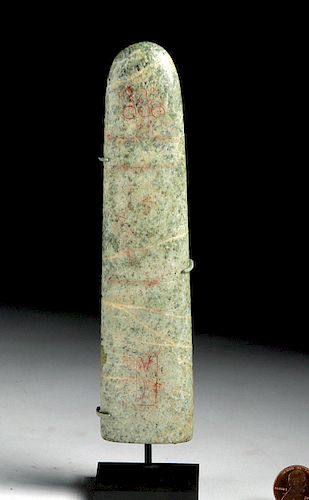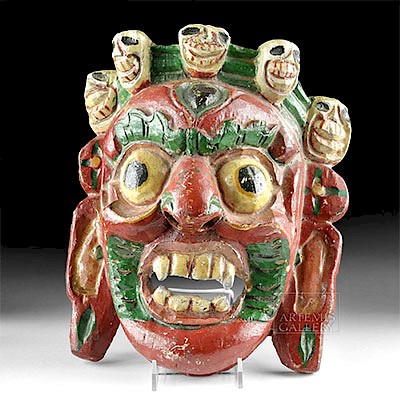Olmec Decorated Stone Celt w/ Cinnabar
Lot 14f
About Seller
Artemis Fine Arts
686 S Taylor Ave, Ste 106
Louisville, CO 80027
United States
Selling antiquities, ancient and ethnographic art online since 1993, Artemis Gallery specializes in Classical Antiquities (Egyptian, Greek, Roman, Near Eastern), Asian, Pre-Columbian, African / Tribal / Oceanographic art. Our extensive inventory includes pottery, stone, metal, wood, glass and textil...Read more
Estimate:
$4,000 - $6,000
Absentee vs Live bid
Two ways to bid:
- Leave a max absentee bid and the platform will bid on your behalf up to your maximum bid during the live auction.
- Bid live during the auction and your bids will be submitted real-time to the auctioneer.
Bid Increments
| Price | Bid Increment |
|---|---|
| $0 | $25 |
| $300 | $50 |
| $1,000 | $100 |
| $2,000 | $250 |
| $5,000 | $500 |
| $10,000 | $1,000 |
| $20,000 | $2,500 |
| $50,000 | $5,000 |
| $100,000 | $10,000 |
| $200,000 | $20,000 |
About Auction
By Artemis Fine Arts
Apr 25, 2019
Set Reminder
2019-04-25 10:00:00
2019-04-25 10:00:00
America/New_York
Bidsquare
Bidsquare : Pre-Columbian | Tribal | Ethnographic
https://www.bidsquare.com/auctions/artemis-gallery/pre-columbian-tribal-ethnographic-4035
Featuring ancient and ethnographic art from around the world, including Pre-Columbian, Native American, African / Tribal, Ethnographic, Spanish Colonial, Fossils, Fine Art, much more. Artemis Fine Arts info@artemisgallery.com
Featuring ancient and ethnographic art from around the world, including Pre-Columbian, Native American, African / Tribal, Ethnographic, Spanish Colonial, Fossils, Fine Art, much more. Artemis Fine Arts info@artemisgallery.com
- Lot Description
Pre-Columbian, southern Mexico/northern Guatemala, Olmec culture, ca. 10th to 6th century BCE, probably later in the period. A ceremonial banded greenstone hand axe (celt) with cream-colored, swirling inclusions, one of its faces incised with fascinating iconography marked out with dark red cinnabar. The surface has been polished to a semi-glossy finish. Incised near the curved top of the celt is a series of three avian forms atop round discs; below are two horizontal lines, perhaps sectioning off the top of the lower part of the celt; then a human face in profile, with an almond-shaped eye, small nose, and large lips that turn down at the corners in a classic Olmec form; finally a partially obscured, abstract zoomorphic form near the flat base. Size: 1.5" W x 6.45" H (3.8 cm x 16.4 cm); 7.45" H (18.9 cm) on included custom stand.
The Olmec are the ancestors of all Mesoamerican civilizations, and their artistic style, practiced in the tropical lowlands of south central Mexico and diffused outward through extensive trade networks that stretched into northern Mexico and central America, was inspirational for those who came after. The face may represent a god or an idealized example of the perfect face; for example, the earliest portrayals of the maize god in Maya art were modeled upon the faces depicted in Olmec art. The other incised forms on this carving are probably epi-Olmec or proto-Mayan. Epi-Olmec, like Mayan, consists of glyphs, often written in lines or columns. Although little of it has been deciphered, what we know of this language is that it describes religious notions and, to a lesser extent, socio-political matters. It is not clear if glyphs are both pictographic and ideographic, or what role phonograms might have played, and this remains a hotly debated component of Mesoamerican archaeology.
Provenance: ex-Howard Rose Gallery, New York, USA, ex-private Albert J. & Monique Grant collection, New York, USA, acquired 1950s-1960s
All items legal to buy/sell under U.S. Statute covering cultural patrimony Code 2600, CHAPTER 14, and are guaranteed to be as described or your money back.
A Certificate of Authenticity will accompany all winning bids.
We ship worldwide and handle all shipping in-house for your convenience.
#144371Wear on surface commensurate with age. Motifs are well preserved and generally very easy to see, with nice remaining cinnabar pigment.Condition
- Shipping Info
-
All shipping is handled in-house for your convenience. Your invoice from Artemis Gallery will include shipping calculation instructions. If in doubt, please inquire BEFORE bidding for estimated shipping costs for individual items.
-
- Buyer's Premium



 EUR
EUR CAD
CAD AUD
AUD GBP
GBP MXN
MXN HKD
HKD CNY
CNY MYR
MYR SEK
SEK SGD
SGD CHF
CHF THB
THB



















